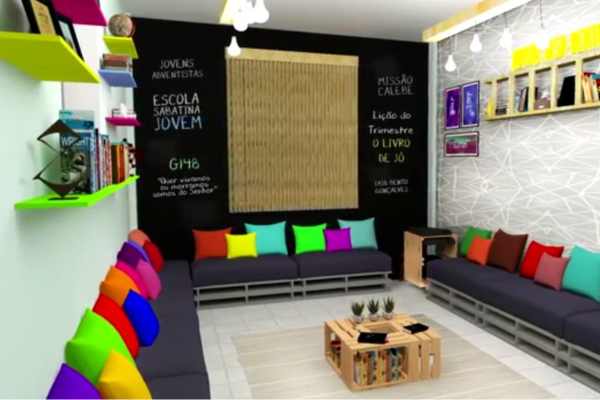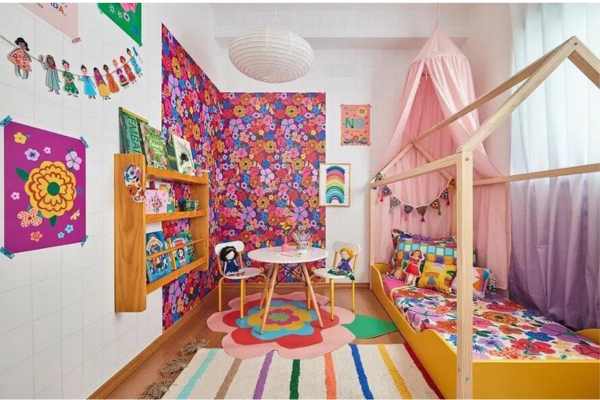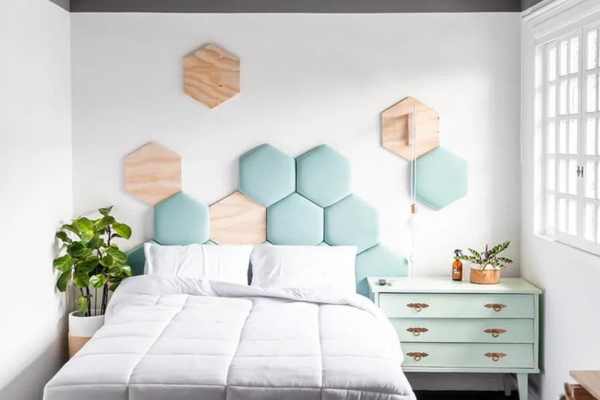The transition from childhood to adolescence is a significant phase in any young person’s life, and adapting the room is a meaningful way to support this change.
This article will present 10 topics covering specific adaptations and activity suggestions that can involve parents, fostering family harmony during this crucial period.
1. Co-Creation of Room Design
Involving the teenager in co-creating the room’s design is crucial. Conducting brainstorming sessions together, exploring decoration magazines, and creating inspiration boards can be an engaging activity for the whole family.
Do It Yourself (DIY):
Suggest DIY projects to personalize decorative items, such as frames, cushions, or lamps, adding a personal touch to the environment.
2. Choice of Relevant Colors and Themes
Allowing the teenager to choose the room’s colors and theme is empowering. This not only reflects their personality but also encourages autonomy in decision-making.
Do It Yourself (DIY):
Propose creating an inspiration wall using paint samples and magazine cutouts to visualize color and theme choices.
3. Functional and Versatile Furniture
Investing in functional and versatile furniture is a smart adaptation. Beds with storage space, extendable tables, and modular organizers are practical choices.
Do It Yourself (DIY):
Transform an old dresser into a unique furniture piece by painting it or applying decorative adhesive paper.
4. Comfortable Study Nook
Create a cozy study nook to encourage the teenager to focus on studies. Choose an ergonomic desk, good lighting, and a comfortable chair.
Do It Yourself (DIY):
Personalize the study area with a corkboard to hang reminders, photos, and inspiring ideas.
5. Collaborative Decorating Activities
Turning room decoration into a collaborative activity can strengthen family bonds. Paint a wall together, create murals, or even a memory collage.
Do It Yourself (DIY):
Encourage the creation of personalized art to hang in the room, whether through paintings, drawings, or collages.
6. Responsible Technology Integration
Integrating technology into the room is inevitable but should be done responsibly. Organize charging stations for devices and promote time limits for electronic use.
Do It Yourself (DIY):
Create a cable organizer to keep chargers in order and prevent wires from cluttering the room.
7. Decoration with Memories
Incorporate elements that bring back good memories. Place photos, tickets from special events, or any item that holds personal significance.
Do It Yourself (DIY):
Make a Polaroid wall or create a memory board using objects that represent special moments.
8. Space for Physical Activities and Leisure
Dedicate space for physical activities and leisure. It could be an area for practicing yoga, a bike stand, or even a small dance space.
Do It Yourself (DIY):
Build shelves to store sports equipment, such as exercise balls or jump ropes.
9. Cozy and Ambient Lighting
Lighting plays a crucial role in the room’s atmosphere. Opt for a combination of ambient lighting and directed lights for different activities.
Do It Yourself (DIY):
Create personalized lamps using simple materials like glass jars, ropes, and LED lights.
10. Space for Creative Expression
Finally, reserve space for creative expression. It could be a wall for drawings, an easel for paintings, or even a shelf for storing artistic materials.
Do It Yourself (DIY):
Build a canvas stand using wood and nails, encouraging the practice of painting and artistic expression.

Conclusion: A Shared Transition Journey
Adapting a child’s room to a teenager is a unique journey that can be enriched by collaborative activities and DIY projects.
By involving parents, the teenager not only receives a renovated room but also experiences the importance of family during this transition phase.
The result is a space that reflects the teenager’s identity and strengthens family bonds.
Keep reading our articles:
Incorporating Heroic Elements into Decoration
Creating a Corner for Arts and Studies
Frequently Asked Questions about Adapting a Room for Adolescence
1. Why is it important to involve the teenager in the room design process?
Involving the teenager in the room design process is crucial to ensure the space reflects their personality and preferences. It also promotes autonomy and decision-making while strengthening family bonds through collaborative activities like brainstorming sessions and DIY projects.
2. What colors and themes are recommended for a teenager’s room?
Colors and themes should be chosen by the teenager, allowing them to express their identity.
Neutral colors or pastel tones can be paired with themes that reflect their interests, such as music, sports, or art. The key is that the room should be a reflection of who they are.
3. How do you choose functional and versatile furniture for a teenager’s room?
Choosing functional and versatile furniture is essential for optimizing space. Opt for beds with storage space, extendable desks, and modular organizers.
These items are practical and help keep the room organized while adapting to the teenager’s ever-changing needs.
4. How can you create a comfortable and productive study environment?
A comfortable and productive study environment should include an ergonomic desk, a comfortable chair, and good lighting.
Personalizing the space with items like a corkboard for reminders and inspirations can also make the area more appealing and motivating for the teenager.
5. What is the importance of integrating technology responsibly in the room?
Integrating technology responsibly is important to avoid distractions and promote healthy use of electronic devices.
Organizing charging stations and setting time limits for device usage are effective ways to ensure technology is used in a balanced and productive manner.


